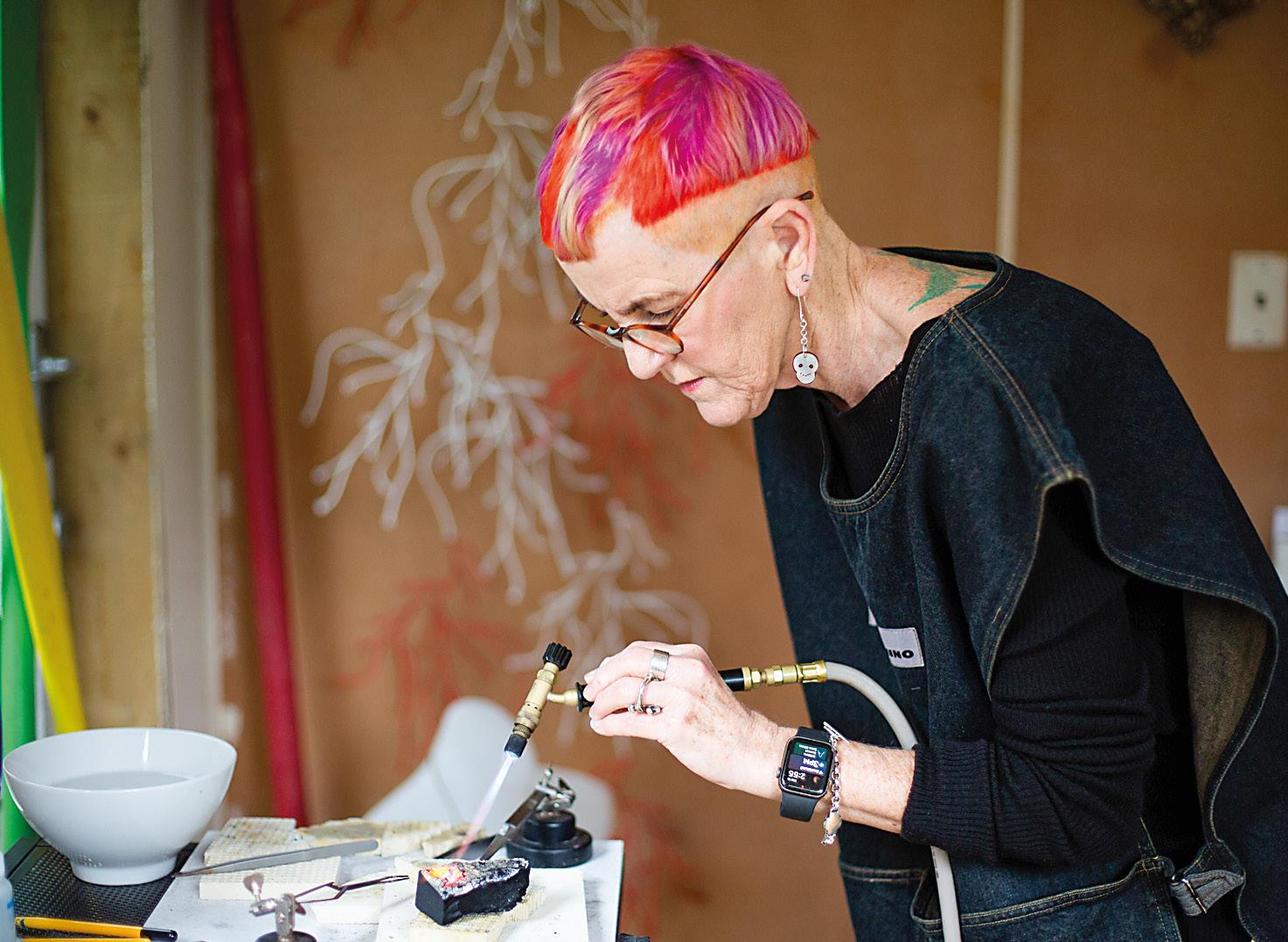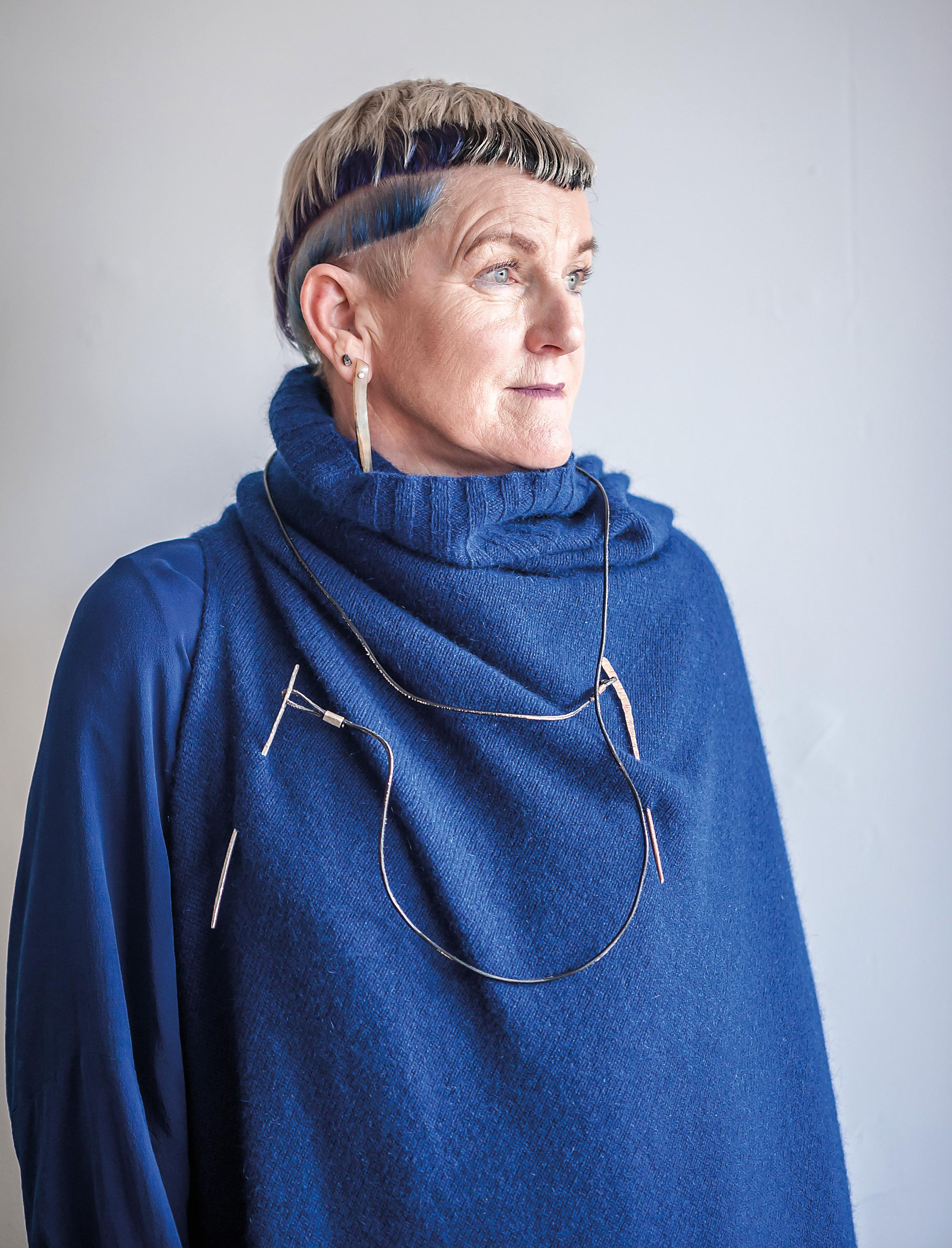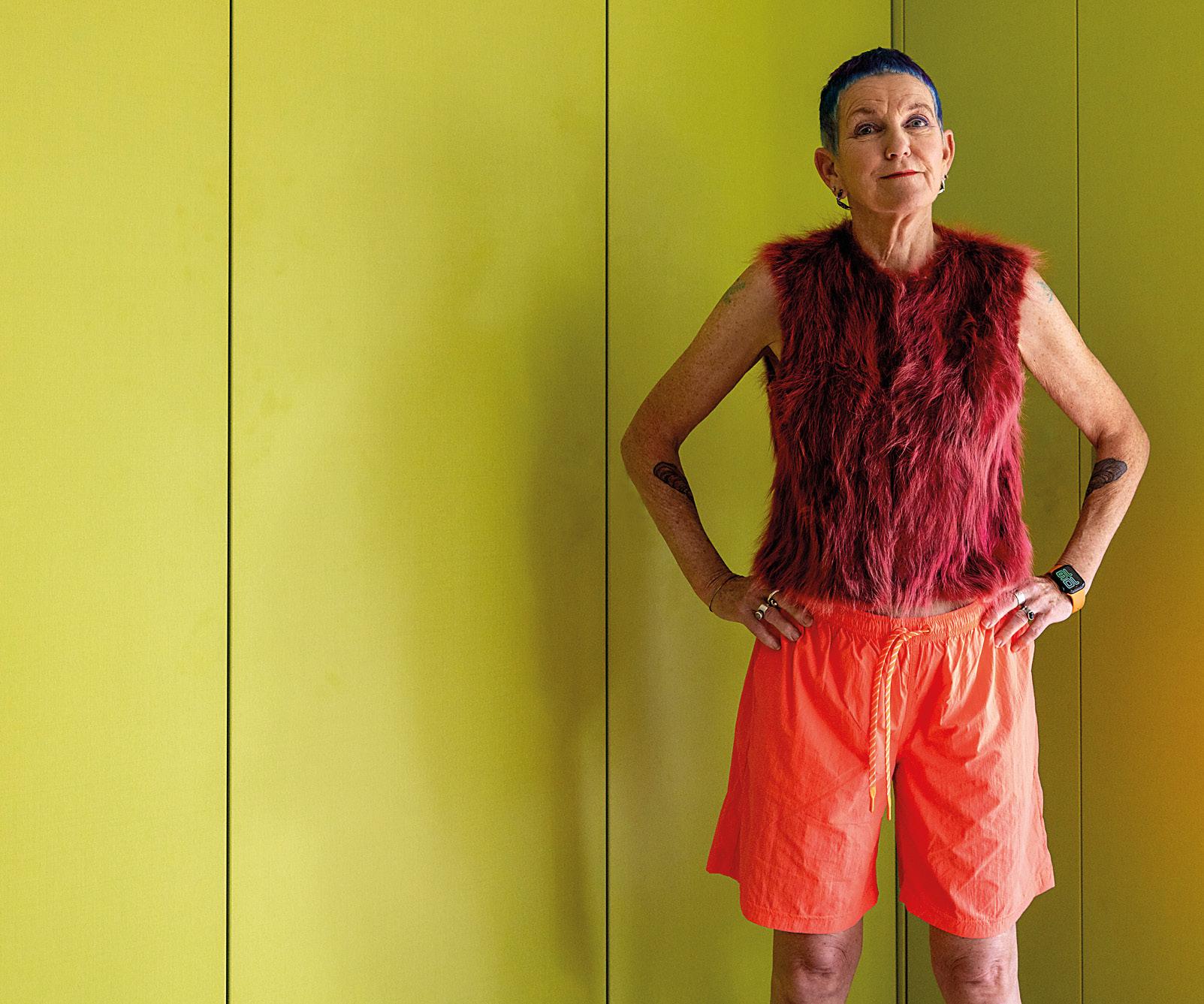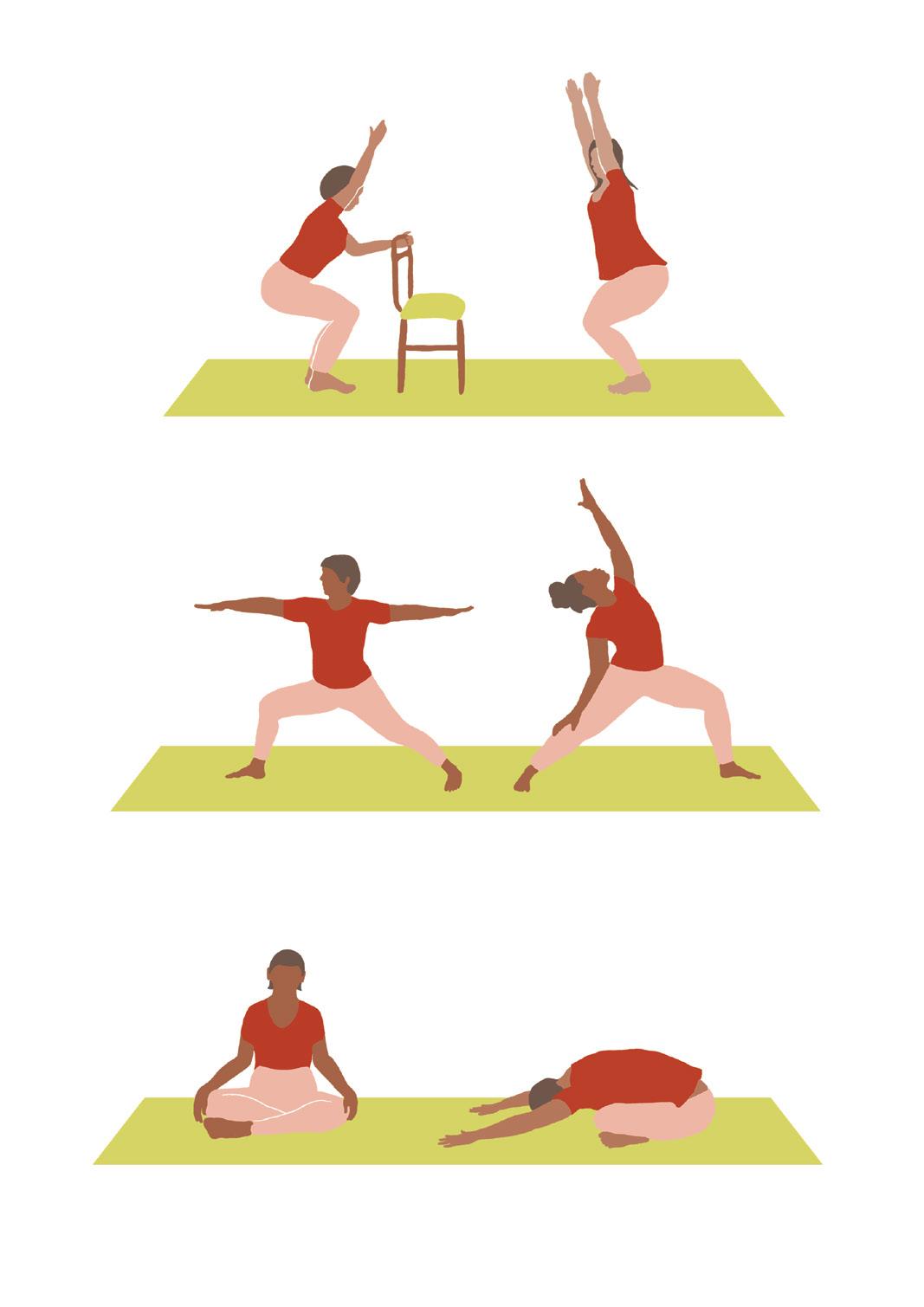
7 minute read
FOCUSING ON THE HERE AND NOW
With nearly a quarter of a century of yoga practice under her belt, Titirangi’s Judi Clements shares why she loves yoga so much and how it has come to help her diabetes.
Judi Clements discovered yoga when living in east London 24 years ago. Good fortune had her living not far from a Buddhist centre, where she says she was able to experience both meditation and yoga within a traditional setting. Starting with the centre’s beginners’ classes, Judi found herself falling in love with the centuries-old form as she began learning about the physical and psychological benefits of yoga.
Years later, Judi moved to Aotearoa New Zealand to take up the role of Chief Executive of the Mental Health Foundation. ‘I did that for 11 years and then had my bucket list of things to do when not in full-time work. Learning the techniques and creating jewellery with different sorts of metals was top of the list, and yoga was second on the list.’
Judi says she has always done some form of exercise. But it wasn’t until she stepped back from the daily grind of work and took on subcontracting, coaching, and consultancy that she was able to find the time for more yoga. ‘I think the benefits are always there though, whether you do it intermittently or not.’
Diagnosed with type 1 diabetes at 23 years old, Judi says she has experienced a lot of different forms of medical treatment and improvements over that time. ‘But, the one thing that I’ve noticed to be constant is that your wellbeing and your care as a person with diabetes is largely down to yourself. Exercise and diet and lifestyle are critically important, and yoga seems to particularly help me. Maybe because I cycle to the yoga studio as well.’
Judi practices yoga most days, both in a local studio with others and, on occasion, within the privacy of her own home, following an online tutor. ‘But I quite like the collegiality of doing it in a group, and I think there are rich experiences in those settings. That, and we also all get to have a chat afterwards.’
One of things Judi enjoys about doing yoga with others is being around people who are all moving with focus and in a completely noncompetitive and non-comparative way. ‘It’s not like I’m training to do a marathon or training to play competitive sport. It’s a very different sort of mindset to learn about your own body, what works for you, and what makes you feel good.’
At 71, Judi is probably the oldest person in the classes she goes to. She freely admits to occasionally taking a sneaky look at the young people around her. ‘I’m thinking, my God, they’re so beautiful. I know that I will not be able to get anywhere near that level of ability and flexibility because at 71 I just haven’t got that level of flexibility. But it doesn’t stop me trying. I just keep thinking this is my body and this is what I can do.’

‘IT’S GROUNDING, IT’S AFFIRMING, IT CAN BE CHALLENGING, BUT IT CAN BE SO SATISFYING’
Yoga isn’t just about stretching and breathing. Primarily, yoga is structured movements which move the body into held poses or ‘asanas’. Getting into and then holding these poses is what offers not just flexibility but strength as well, and breathing is sequenced alongside the movements to help the body and mind ease into what it’s being asked to do.

Judi finds that her practice, as well as being an exercise that gently and gradually strengthens and stretches the muscles, also has an emotional and psychological benefit. ‘I feel better after being at a yoga session, even if I’m tired and I’m thinking, do I really want to do this. Yesterday I went, and I was not in a great mood. I was feeling a bit scratchy and fractious, but by the time I’d done an hour’s yoga I felt like the world was a better place. It really is blissful.’

Yoga is where Judi goes to experience a clear mind.
STYLE WISE
Judi has done a number of different yoga styles over the last 25 years. Her first classes that she did with the Buddhist Centre were in Iyengar, a style which focuses on aligning the body. Locally, she does Vinyasa classes, which are designed around salutes to the sun – gentle repetitive full body exercises designed to wake up the body. Sometimes, Judi goes to Yin. ‘It can be described as merely holding a gentle posture for 5–6 minutes. But actually it’s pretty challenging as the mind wants to take over and get you to get up and get jobs done. At Yin, you learn to calm.’
But possibly where Judi finds most enjoyment is experiencing a clear mind. Thinking about anything else is not something Judi says she can do while in a yoga class. Whereas with other activities it’s often possible to fit in shopping list additions and concerns, everyday worries have to take a break for an hour or so. ‘I find yoga is great for just focusing on the here and now and being in the present.’
SIMPLE SET UP
Beginning and practicing yoga requires very little equipment. A thin mat that allows you to not slip on the floor is useful, and loose or stretchy clothing makes it easier to move for one pose to another.
Beginners classes are recommended if you’ve never done yoga before as this is where students learn the correct alignment, which in turn teaches you how to avoid injury.
Every city and most towns have someone teaching yoga. Check out your local community centres. You can find yoga in studios, churches, and gyms. Some classes are offered seasonally in parks or on the beach or even at a native bird sanctuary, such as Wellington’s Zealandia.
Costs can vary from koha (donation) to $20+.
There are a few different styles of yoga out there: Iyengar, Vinyasa, Hatha, Anusara, Kundalini, Bikram, Ashtanga, Yin, and more. Yoga can be designed for those who are pregnant, adapted for those who have injuries, and adjusted to suit people who are more confined to a chair.
Youtube and social media platforms host many practitioners who offer free classes and advice on yoga. ‘Yoga with Adriene’ is popular. For those with limited mobility, ‘scotteeisfat’ is an inspiring teacher whose posts guide and explain how any shape of body can still do and benefit from yoga. You can find him on Instagram, X, and Threads.
Here are three starter poses to get you going. Adapt the poses to suit your body and use a chair if you need the support.
STRENGTH
1. Chair pose/ Utkatasana/ Nohoanga
From standing (feet facing forward, two fists distance apart), inhale then exhale as you bend your knees and move your hips backward, as if sitting down on a chair. Raise your arms in front of you as high as they will go. Hold for five smooth breaths.
(Strengthens legs, back muscles, core, and concentration.)
POWER
2. Warrior 2/ Virabhadrasana 2/ Toa Tuarua
From standing (feet two fists distance apart), inhale then exhale as you take a big step directly back with your left leg. Turn your body and your right foot to be in line with the long edge of your mat. Raise your arms parallel to the floor, bend your front leg, and turn your head to face forward.
Hold for five smooth breaths. Change sides.
(Strengthens legs and arms, and gives a sense of power.)
Progress to: Reverse Warrior – lift left arm to the sky while the right arm lowers down your leg. Hold for three smooth breaths.
(Strengthens core.)
RECOVER AND STRETCH
3. Easy cross-legs/ Sukhasana/ Whiringa Waewae
Hold for five smooth breaths. Extend the time gradually.
Progress to: gradually walking the hands out away from the body.
(Gradually relaxes and stretches hips and lower back.)











